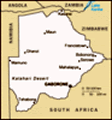Advertisement
Published: September 24th 2012
Kabale and Chobe National Park and River 22 & 23 August
After leaving Livingstone at 7.30am after a hot breakfast at the restaurant, with our new group and new guides, we had to travel only 2 hours to the border to Botswana. The border crossing went smoothly even though our guides were not looking forward to it as past times the border crossing has taken 4 hours. Immediately after the border crossing, we crossed the mighty Chobe River by a short ferry ride. The ferry only fitted our truck and one other vehicle. The Chobe River flows into the Zambezi River and eventually flows out into the Ocean through Mozambique.
What is interesting about this ferry crossing is that in the middle of the river is the joining of the Zambia, Namibia, Botswana, and Zimbabwe borders. Namibia has a long narrow bit of land that meets this point. Very unusual.
After the ferry crossing we went to our camp site and set up our tents then went into town (Kabale) to get some Botswana money (Bulia $US1.00 to 8.1 B)
and do some shopping. We quickly noticed that we were in a country that is far more developed than all the other countries we have visited so far. On the way we dropped 2 of our group off to the doctor because one of them was quite sick with a stomach bug. He looked so different when he came back after having 3 injections.
The country we travelled through was hot and dry with medium sized trees and bushes. There were more towns rather than villages.
That evening (22 August) we went on one of the most magnificent 3 hour sunset boat cruises on the Chobe River. Will I ever get tired of this African sunset and sunrises? The sun is literally red at these times. The boat was 2 story so I went up the top. It was in the sun but the breeze was beautiful and the view was excellent. We saw 100s of elephants, buffalo, hippos, several crocodiles, and 1000s of birds. We shared cheese, forgot the crackers and wine!!!! None the less, it was an excellent cruise getting up close and personal
to all these animals.
And the finale – that sunset!!!! Do the photos do it justice with the red sun’s reflections shimmering on the ripples of the water? Beautiful!
The next morning (23 August – I have no idea what day it is except that my digital camera is showing that we have been away for 43 days – wow, it is going fast!! ) we got up at 5.00am so that we could be in the Chobe National Park before sunrise.
Chobe National Park, in northern Botswana, has one of the largest concentrations of game in Africa. By size, it is the third largest park of the country, after the Central Kalahari Game Reserve and the Gemsbok National Park, and is the most diverse. It is also the country's first national park.
The park can be divided up to 4 areas, each corresponding to one distinct ecosystem, which we visited only one, the on Chobe riverfront.
The Serondela area (or Chobe riverfront), situated in the extreme
Northeast of the park, has as its main geographical features lush floodplains and dense woodland of mahogany, teak and other hardwoods now largely reduced by heavy elephant pressure. The Chobe, which flows along the Northeast border of the park, is a major watering spot, especially in the dry season (May through October) for large breeding herds of elephants, as well as families of giraffe, sable and cape buffalo. The flood plains are the only place in Botswana where we saw the large puku antelope. Birding is also excellent here. Large numbers of carmine bee eaters were spotted. We saw spoonbills, ibis, various species of stork, duck and other waterfowl flock to the area. This is probably the most visited park section, partly because of its proximity to the Victoria Falls. The town of Kasane, situated just downstream, is the most important town of the region and serves as northern entrance to the park.
Chobe is home to vast herds of Elephants. These are the Kalahari elephants and are the biggest in Africa but often have broken tusks, this is due to the lack of calcium in their diet which renders them brittle. All
the other large animals are present except Rhino which have been driven to local extinction due to poaching. We saw all of them.
We then drove back to camp for a hearty breakfast. We then packed our tents up and drove to our next stop, Gweta.
Advertisement
Tot: 0.047s; Tpl: 0.016s; cc: 9; qc: 23; dbt: 0.0212s; 1; m:domysql w:travelblog (10.17.0.13); sld: 1;
; mem: 1.1mb























